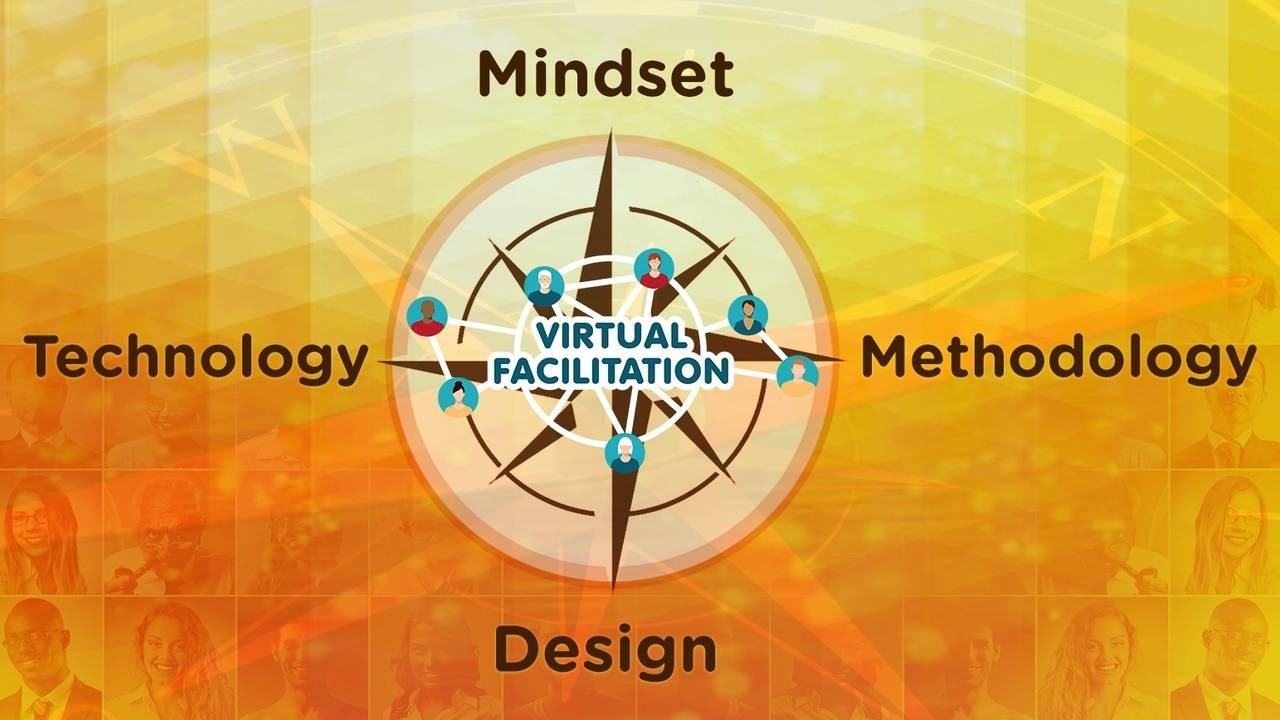Our Compass in Virtual Facilitation

Since 2018, we held over 80 Cohorts in our Virtual Facilitation Workshop, training more than 1,000 professionals in 3 languages. On this journey, aiming to equip Facilitators, Educators and Consultants, we identified fundamental dimensions of Virtual Facilitation. At first, these dimensions were two: Technology and Methodology.
Technology
Perhaps this is the first and most obvious layer, as all virtual interactions happen mediated by hardware (computer, camera, headphones, etc.) and software (video conferencing platform, word processor, whiteboard, etc.). There are many options, and it keeps evolving every day. For technophiles, a paradise. For technophobes, a nightmare. The bottom line is: you need to understand and master some fundamental tools.
Methodology
For those with a background in facilitation, it is common to have a wide range of methods, processes, theories and approaches to work with groups. And of course, this ‘bag of tricks’ keeps growing over time. Transitioning to the virtual environment, however, is neither simple nor easy. Some methods work very well, others not so well, and time perception is quite different from the face-to-face environment. In this dimension, it is essential to test and adapt known methods and incorporate new techniques to achieve the expected results.
We spend a lot of time exploring these two dimensions due to the volatility of Technology, which evolves very quickly. And we also carry out numerous tests and adaptations of ‘analog’ methods in a fun learning journey of ‘digital’ methods. And while playing with these two dimensions, a third was unveiled: Design.
Design
To achieve excellent results in virtual facilitation it is necessary to combine technology and methods properly. This combination, when smooth, enriches the experience of individuals, optimizes the use of time and maximizes results.
Just a good method or good software is not enough. A good design elevates the group interaction and brings results to the point where technology and process go unnoticed.
Design in virtual facilitation takes a lot of practice and attention to detail. A tip to accelerate the development in this dimension is to share your storyboards and constantly ask for suggestions and feedback from other facilitators. Often an outside perspective will help you simplify a process, choose a better tool, and even spice the Design with something new…😉
It is noteworthy that virtual facilitation requires a careful, attentive design and in the end, this extra mile improves the quality of the facilitation.
As I said before, we are always looking for better ways to transfer our knowledge and practice and to train professionals quickly and consistently. More recently we identified a fourth dimension that brought more clarity about the learning process in our Workshops: The Mindset.
Mindset
The fourth dimension is what literally ‘shows the North’ in Virtual Facilitation. A Mindset, or mental model, requires more time and effort to develop. When we think in the digital format from the start (instead of adapting our face-to-face experience to the digital) the design process becomes more fluid and creative.
An important tip here is self-observation and constant feedback exchange with other virtual facilitators to recognize our ‘analogic’ beliefs and habits when transitioning online.

In this (long) journey it will be necessary to let go of some habits to get new ones, such as:
• Old F2F habit: (Over)Help the group by summarizing and documenting participants’ discussions and decisions, usually using a flip-chart.
• New Digital habit: Provide structure and give autonomy for participants to work in small groups, documenting their discussions and decisions in shared documents on their own.
+ Old F2F habit: Have as visual support as a set of slides projected on a big screen, which in the virtual became excessive ‘screen sharing’.
+ New Digital Habit: Share with participants the link to the slides, announcing verbally which slide you are working on, empowering the group and increasing engagement.
» Old F2F habit: Relying on your own ‘group reading skill’ to assess whether the process is moving forward satisfactorily and whether everyone is engaged and productive.
» New Digital Habit: Verbally check with the group, asking for explicit indications that the process is moving forward and that everyone is ‘onboard’.
Invite everyone to assess their experience during sessions (e.g., is your: connection with others deepening… understanding of context growing… range of possibilities or options expanding).
Reviewing and summarizing the four dimensions:
Technology: the most explicit and objective dimension. Identify what is needed, and learn by doing. Less is more.
Methodology: a wide field for experimentation and creative adaptation. Simplifying and breaking long processes into short steps is fundamental. Short and simple processes always bring positive results.
Design: huge learning and exchange opportunity with peers. Connect, expand your network, and exchange as much as possible. The more you give, the more you get. Pilot, test, experiment with people in your network.
Mindset: an endless journey of self-observation and self-development. Enjoy the trip and have fun. Laughing at yourself is a relief…😜
• • •
I hope this model and the tips above can unveil areas for development on your journey!
Working remotely consistently since 2015, I have had the privilege of meeting amazing people who contributed with my development. For all of them I am truly grateful. My intention here is to simply share what I’ve been learning and keep exchanging and evolving with all Facilitators.

